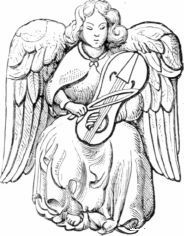MUSICAL INSTRUMENTS - online book
The History And Development Of Musical Instruments From The Earliest Times.
| Share page | Visit Us On FB |
|
MUSICAL INSTRUMENTS. |
93 |
||
|
dered bv the artist who drew the figures as the noblest instrument. It was probably identical with the rotta of the same century on the continent.
An interesting drawing of an Anglo-saxon fiddle—or fithiclc, as it was called—is given in a manuscript of the eleventh century in the British museum (Cotton, Tiberius, c. 6). The instrument is of a pear shape, with four strings, and the bridge is not indicated. A German fiddle of the ninth century, called lyra, copied by Gerbert from the manuscript of St. Blasius, has only one string. These are shown in the woodcuts (p. 97). Other records of the employment of the fiddle-bow in Germany in the twelfth and thirteenth centuries are not wanting. For instance, in the famous 'Nibelungenlied'Volker is described as wielding the fiddle bow not less dexterously than the sword. And in ' Chronicon picturatum Brunswicense' of the year 1203, the following miraculous sign is recorded as having occurred in the village of Ossemer: " On Wednesday in Whitsun-week, while the parson was fiddling to his peasants who were dancing, there came a flash of lightning and struck the parson's arm which held the fiddle-bow, and killed twenty-four people on the spot."
Among the oldest representations of performers on instruments of the violin kind found in England those deserve to be noticed which are painted on the interior of the roof of Peterborough cathedral. They are said to date from the twelfth century. One
 |
|||